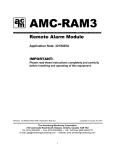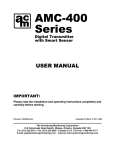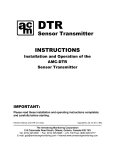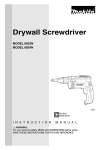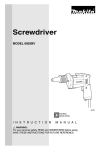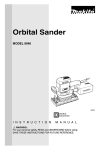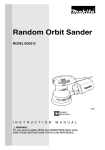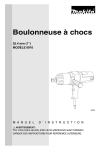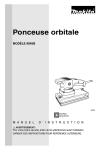Download Armstrong AMC-210 Series Operating instructions
Transcript
210 Series Transmitter with External Electrochemical Sensor INSTRUCTIONS Installation and Operation of the AMC-210 Series Transmitter with External Electrochemical Sensor IMPORTANT: Please read these installation and operating instructions completely and carefully before starting. Filename: Manual_amc210_trx w external electrochemical sensor.doc Revised, Nov.2012 Copyright ©, Feb. 2004, AMC The Armstrong Monitoring Corporation 215 Colonnade Road South, Ottawa, Ontario, Canada K2E 7K3 Tel: (613) 225-9531 • Fax: (613) 225-6965 • Canada & U.S. Toll Free: 1-800-465-5777 E-mail: [email protected] • Internet: www.armstrongmonitoring.com NOTE This page intentionally left blank. AMC-210 Transmitter with external electrochemical sensor TABLE OF CONTENTS Section Title Page 1 WARRANTY............................................................................................................. 3 1.1 LIABILITY........................................................................................................... 3 1.2 PRODUCT RETURN ......................................................................................... 3 1.3 MODIFICATIONS AND SUBSTITUTIONS......................................................... 3 2 PRODUCT INFORMATION...................................................................................... 4 2.1 SENSOR/TRANSMITTER.................................................................................. 4 2.2 FACTORY CALIBRATION ................................................................................. 5 2.3 HOUSING OPTIONS ......................................................................................... 6 3 INSTALLATION ....................................................................................................... 7 3.1 LOCATION AND MOUNTING............................................................................ 7 3.2 CABLE SELECTION AND WIRING ................................................................... 8 3.2.1 3.2.2 4 TRANSMITTER TO MONITOR WIRING...............................................................10 INTERFACING TO COMPUTER, DATALOGGER, OR NON-AMC MONITOR ....11 OPERATION AND CALIBRATION ........................................................................ 12 4.1 OPERATION .................................................................................................... 12 4.2 CALIBRATION ................................................................................................. 12 4.2.1 EQUIPMENT REQUIRED .....................................................................................13 4.2.2 TRANSMITTER CALIBRATION/VERIFICATION SET-UP PROCEDURE............13 RECALIBRATION................................................................................................................14 5 PREVENTIVE MAINTENANCE.............................................................................. 15 5.1 GENERAL ........................................................................................................ 15 5.2 SCHEDULED CALIBRATION .......................................................................... 15 5.3 SENSOR REPLACEMENT .............................................................................. 15 6 ADDENDUM (FOR OXYGEN ONLY)..................................................................... 17 1 AMC-210 Transmitter with external electrochemical sensor NOTE This page intentionally left blank. 2 AMC-210 Transmitter with external electrochemical sensor 1 WARRANTY The AMC-210 transmitter is warranted against defects in material and workmanship for a period of two (2) years from date of shipment (except electrochemical sensor elements, catalytic elements and portable monitors – one (1) year – refer to individual spec sheets for additional exceptions). Calibration is not warranted. During the warranty period, Armstrong will repair or replace components that prove to be defective in the opinion of Armstrong Monitoring. The corporation is not liable for auxiliary interfaced equipment, nor consequential damage. NOTE: Any substitution or tampering with components without expressed, written permission of ARMSTRONG MONITORING may result in intrinsic damage which will cancel the effectiveness of the warranty. Extended warranties are available through the factory. Please contact factory. Service agreements may supersede standard warranty terms. 1.1 LIABILITY All Armstrong Monitoring systems shall be installed by a qualified technician and maintained according to Armstrong Monitoring Installation and Maintenance Manual instructions. Armstrong Monitoring shall not be responsible for any liability arising from auxiliary interfaced equipment, consequential damage, the installation, or the operation of this equipment. Armstrong’s total liability is contained in the warranty conditions stipulated above. No other acceptance of liability is expressed or implied by Armstrong Monitoring. Except as set forth herein, Armstrong Monitoring makes no warranty, expressed or implied, with respect to the fitness for any particular purpose or use or otherwise of the products or services, or on any parts or components or labour furnished as part of the sale. In no event shall Armstrong Monitoring, its officers, directors, employees, agents or servants be liable to the buyer or any other party for any loss of profit, loss of use, incidental, consequential or special damages arising out of the sale, delivery, servicing, use, loss of use, of the products or of any part thereof, irrespective of whether Armstrong Monitoring or any of its officers, directors, employees, agents or servants has advanced notice of the possibility of such damages. In no event will the total liability to the buyer exceed the sum paid to Armstrong Monitoring by buyer for the products and services. 1.2 PRODUCT RETURN All products that must be returned for warranty service will be shipped by prepaid freight and will only be accepted with a Returned Materials Authorization (RMA) number issued by ARMSTRONG MONITORING. Goods returned to the client will be by freight collect. 1.3 MODIFICATIONS AND SUBSTITUTIONS Due to an ongoing development program, Armstrong Monitoring reserves the right to modify the design and substitute components in any of its products without prior notice. All changes are at the sole discretion of Armstrong Monitoring, and the corporation shall not be liable for any cost arising out of such modifications or substitutions that may be incurred by the user. 3 AMC-210 Transmitter with external electrochemical sensor 2 PRODUCT INFORMATION The AMC-210 series sensor/transmitter is designed to provide continuous, reliable surveillance of surrounding air for traces of a specific hazardous gas(es) (listed in section 2.2). This unit provides a 4 to 20 mA, variable current signal, which is proportional to the gas concentration detected. Each sensor/transmitter unit is factory calibrated and is ready for field installation and operation. 2.1 SENSOR/TRANSMITTER Operating Temperature. ……………………………………. Humidity ……………………………………………………… % RH, non-condensing Sensor/Transmitter Unit Order Number …………………… Sensor/Transmitter Serial Number…………………………. Sensor Type ………………………………………………….. Electrochemical cell. Sensor Part Number...……………………………………….. Sensor Serial Number……………………………………….. Expected Sensor life…………………………………………. Sensor Warranty ……………………………………………... Power Supply Requirement ………………………………… 12 to 30 VDC @ 20 mA Note: Turn off power supply before removing or replacing the transmitter or sensor. 4 AMC-210 Transmitter with external electrochemical sensor 2.2 FACTORY CALIBRATION Gas Type……………………………………………….…..…. Zero Gas, at 4 mA Signal…………….………………..……. Gas Concentration at 20 mA Signal……………………….. Calibration Adapter Part Number…………………………… Note: All Armstrong Monitoring systems must be installed and maintained according to instructions to assure proper operation. Only qualified technicians should install and maintain the equipment. 5 AMC-210 Transmitter with external electrochemical sensor 2.3 HOUSING OPTIONS The AMC-210 series sensor/transmitter units are available in the housings shown in Figure 1. The explosion proof transmitter housing is rated explosion proof for Class 1, Groups B, C and D locations and can have a corrosion resistant finish (optional). The sensors are also available as standard or explosion proof. PVC HOUSING: Rectangular PVC with cover plate held by four screws. Not for use in combustible areas and not weather proof. Width: Height: Length: Hub Size: 2.9” 2.25” 6” 3/4” NPT EXPLOSION-PROOF HOUSING: Round housings with threaded cover. Weatherproof and explosion proof. BCD Housing: Width: Height: Length: Hub Size: 3.7” 2.6” 5.25” 3/4” NPT FIGURE 1: Transmitter Housing Options. 6 AMC-210 Transmitter with external electrochemical sensor 3 INSTALLATION 3.1 LOCATION AND MOUNTING Mount the sensor/transmitter on a solid, non-vibrating surface or structure in an area where the local concentration of gas is unaffected by the presence of ventilation systems and away from sources of interference gases. (See Figure 2) Note: Mounting arrangement of the housing depends on location and mounting surface. Mounting hardware is not supplied. FIGURE 2: Mounting of Sensor/Transmitter (Explosion Proof Housing) 7 AMC-210 Transmitter with external electrochemical sensor 3.2 CABLE SELECTION AND WIRING Connection should be made using 2-conductor, shielded cable. For best signal transmission and maximum noise rejection, run cable through steel conduit (cable must be grounded at the monitor or power supply). Supply voltage can be measured at the transmitter (–, +) connections at the supply source. For basic cable selection, between the source and transmitter, use a 250ohm load resistance, use the following chart: WIRE GAUGE AWG 22 20 18 16 MAXIMUM DISTANCE IN FEET (METRES) @12VDC 1000 (305) 1500 (457) 2500 (762) 3800 (1158) @24VDC 15000 (4572) 23000 (7010) 38000 (11582) 57000 (17374) For applications not covered by the above chart, an example is shown below for selecting the right cable, using the graph of Figure 3 and the following formulas. Note: Some non-AMC equipment may not have the load resistance built in. Example: Calculations on the graph Maximum resistance …. MR Load resistance ………. LR Known data Power supply ………………………… 17 VDC Load resistance ……………………… 180 Ohms Wire gauge ……………………………20 AWG Cable length / 1 Ohm resistance ….. 43.6 ft (13.3m) typical Formula 1 : To determine remaining safe loop resistance. Maximum resistance Load resistance Remaining resistance 518 Ohms (from Figure 3 graph) - 180 Ohms 338 Ohms Formula 2 : To determine maximum safe cable length allowed. Remaining resistance Cable length (for 1 Ohm) Maximum safe cable length 338 Ohms x 43.6 Feet 14,736 Feet Note: If maximum safe cable length is insufficient, increase the power supply voltage and/or reduce the load resistance. 8 AMC-210 Transmitter with external electrochemical sensor FIGURE 3: Cable selection graph 9 AMC-210 Transmitter with external electrochemical sensor 3.2.1 TRANSMITTER TO MONITOR WIRING The transmitter output (–, +) terminals connect to the (SIG, +) terminals on a channel terminal block of the monitor (one transmitter per channel), as shown in Figure 4. Each transmitter MUST BE CONNECTED TO ITS CORRESPONDING CHANNEL to retain factory calibration of the trip points. FIGURE 4: Transmitter to monitor wiring layout. 10 AMC-210 Transmitter with external electrochemical sensor 3.2.2 INTERFACING TO COMPUTER, DATALOGGER, OR NON-AMC MONITOR All Armstrong sensor/transmitters can be connected to computers or data loggers through analog-to-digital converters or to non-AMC monitors. The transmitter output (–, +) terminals connect to a filtered 12 to 30 VDC power supply through field wiring, as shown in Figure 5. The signal output from the transmitter is a 4 to 20 mA DC current. This signal can be measured or recorded anywhere in the supply loop if required. Alternatively, if a voltage measurement is needed a resistor can be connected between the transmitter negative (–) output terminal and the power supply negative (–) or common terminal, as shown in Figure 5. FIGURE 5: Interfacing to a computer, datalogger or non-AMC monitor. 11 AMC-210 Transmitter with external electrochemical sensor 4 OPERATION AND CALIBRATION 4.1 OPERATION The AMC-210 series sensor/transmitter is factory calibrated for the gas listed in section 2.2 at the beginning of this manual. The sensor/transmitter should not need re-calibration when first installed and powered up, but a test for correct operation is recommended after a stabilization period of 10 minutes. Following stabilization, the sensor/transmitter should be sending (in a Zero Gas environment) a 4 mA signal to the monitor or controller (except oxygen). However, there are a few situations where a slightly higher or lower than normal signal may be noticed. In many facilities there can be residual levels of the gas being detected in the air at all times. These can cause a minor response from the sensor expressed as a rise in signal. Other causes for minor signal variations include extremes in temperature. The application of a clean air sample will verify if the elevated signal is from background gas or equipment error. Although the electrochemical sensors are very selective, there are some interference gases, which can also cause a response from the sensor. These gases are listed on the detailed Specifications sheet pertaining to the sensor in use available from AMC. 4.2 CALIBRATION The transmitter is equipped with a remote calibration feature allowing one-man calibration at the sensor/transmitter location. The transmitter output is measured using a plug-in type “Remote Calibration Lead” (P/N 2900-01) designed to be adaptable to most multimeters. Zero and Span adjustments are made at the transmitter. Recalibration is necessary when replacing the sensor. Verification of calibration should be done at least once every 6 months. For safety reasons and highly demanding applications, monthly verification is recommended. Factory/on-site calibration services, customer training and/or calibration adapter are available. Specify the sensor/transmitter Part Number & Serial Number listed in section 2.1 SENSOR/TRANSMITTER and refer to section 2.2 FACTORY CALIBRATION for Gas Type and calibration adapter when ordering any of the above. Caution: - Only qualified personnel should perform the actual calibration. - Users are advised to consult The Armstrong Monitoring Corporation as to the calibration procedure and recommended gas concentration for the application. For some exotic gases, calibration standards needed for field calibration are not readily available. The Armstrong Monitoring Corporation offers the following calibration plans: 1. Factory pre-calibrated replacement sensor/transmitter units 2. On site installation and calibration by Armstrong Monitoring 3. On site calibration by Armstrong Monitoring 4. Training by Armstrong Monitoring 12 AMC-210 Transmitter with external electrochemical sensor 5. Extended warranty calibration program For all above options, please contact AMC for details. 4.2.1 EQUIPMENT REQUIRED Digital multimeter with a minimum display range of 20.0 mA. Remote calibration lead provided with the transmitter, available from AMC. Miniature screwdriver trimmer adjustment tool. Calibration adapter, available from AMC. Zero & Span gases and regulator (Contact AMC for information). 4.2.2 TRANSMITTER CALIBRATION/VERIFICATION SET-UP PROCEDURE Note: When applying gas, a flow rate of 0.5 to 1 liter per minute is recommended. As the calibration procedure may cause the monitoring equipment to give a false alarm, appropriate precautions should be taken. To perform the following Set-Up procedure (refer to Figure 6) 1) Remove cover from transmitter housing. 2) Plug in standard test leads fully into jacks on multimeter and attach the other end to the test points on the PCB. 3) Switch ON multimeter and select the DC Volts range greater that 1.00 VDC. 4) Apply a Zero gas sample, or with the sensor in clean air, adjust the Zero trimmer for a stabilized reading approaching of 0.000 VDC measured at the test points. This measurement ideally should lie in the range of – 0.005 to 0.000 VDC. 5) Unplug test leads and connect the “Remote Calibration Lead” to the multimeter. BLACK lead to negative or common (–) RED lead to positive (+) 6) Select the next range greater than 20 mA DC full scale on the multimeter. 7) Insert the plug end of the “Remote Calibration Lead” fully into the CAL jack on the transmitter. 8) Adjust the 4 mA trimmer until the multimeter reads 4.00 mA. 9) Apply a Span gas sample and adjust Span trimmer to 20 mA when full-scale gas concentration is used. Note: The Span gas sample need not be of the full-scale concentration but may be a fraction of this. Since the transmitter output range is 4 to 20 mA, a full scale concentration gas should read 20 mA after a few moments of sensor exposure. Similarly, a half scale concentration gas should read 12 mA. 13 AMC-210 Transmitter with external electrochemical sensor RECALIBRATION For full recalibration adjustments, follow the Set-Up procedure steps 1 to 9 inclusive. There are two adjustments to be made for periodic recalibration: Zero and Span. Zero: While there is no gas present (clean air), the transmitter output signal current should read 4 mA. This is obtained by adjusting the Zero trimmer on the transmitter. It is possible, under certain conditions, that the Zero current will fall below 4 mA. Alternately, set the integral display to read “zero” using the zero trimmer with no gas present. Span: While the sensor is exposed to the calibration gas sample, adjust the Span trimmer on the transmitter to set the transmitter output signal current proportional to the applied gas concentration. FIGURE 6: Calibration/Verification Set-up 14 AMC-210 Transmitter with external electrochemical sensor 5 PREVENTIVE MAINTENANCE 5.1 GENERAL The sensor/transmitter unit should be brushed or wiped clean of any dust or dirt at least once a year or more, depending on the rate of accumulation. To avoid sensor damage, the unit MUST NOT be submerged in any liquids. Any hosing or splashing of the unit with any liquids must also be avoided. 5.2 SCHEDULED CALIBRATION Scheduled calibration is critical in maintaining proper function of gas sensor/transmitters. It is recommended that the sensor/transmitter be calibrated a minimum of twice a year. For highly demanding applications, more frequent verification is recommended. As mentioned, Armstrong Monitoring offers a number of different maintenance plans to suit your requirements see section 4.2. 5.3 SENSOR REPLACEMENT Caution: Turn off the power supply before attempting the following. When its signal is greatly reduced or unstable, the sensor/transmitter replacement is required; see section 2.1 for replacement sensor P/N. When sensors are shipped, some sensor leads may be shorted together. This is done to provide rapid stabilization of the sensor signal after installation. To wire the sensor for correct operation, first separate (cut apart) the shorted leads, if any, then connect the RED lead to the “R” terminal, then BLACK to “S” and the YELLOW to “C” of the sensor terminal block on the transmitter. See Figure 7 for the sensor replacement and wiring procedure. Note: Allow 10 minutes for the new sensor to stabilize before performing the calibration procedure in section 4.2.2. 15 AMC-210 Transmitter with external electrochemical sensor FIGURE 7: Sensor replacement and wiring procedure. 16 AMC-210 Transmitter with external electrochemical sensor 6 ADDENDUM (FOR OXYGEN ONLY) This AMC-210 Series (2-wire sensor/transmitter with external electrochemical sensor) has been modified and the following information replaces the terminal block & sensor wiring of Figures 4, 5, 6, and 7. The sensor/transmitter shows that the three wires changed to two wires for OXYGEN SENSOR ONLY. Terminal block & sensor wiring configuration are as shown below: Figure 8: Transmitter wiring layout for oxygen only. 17



















